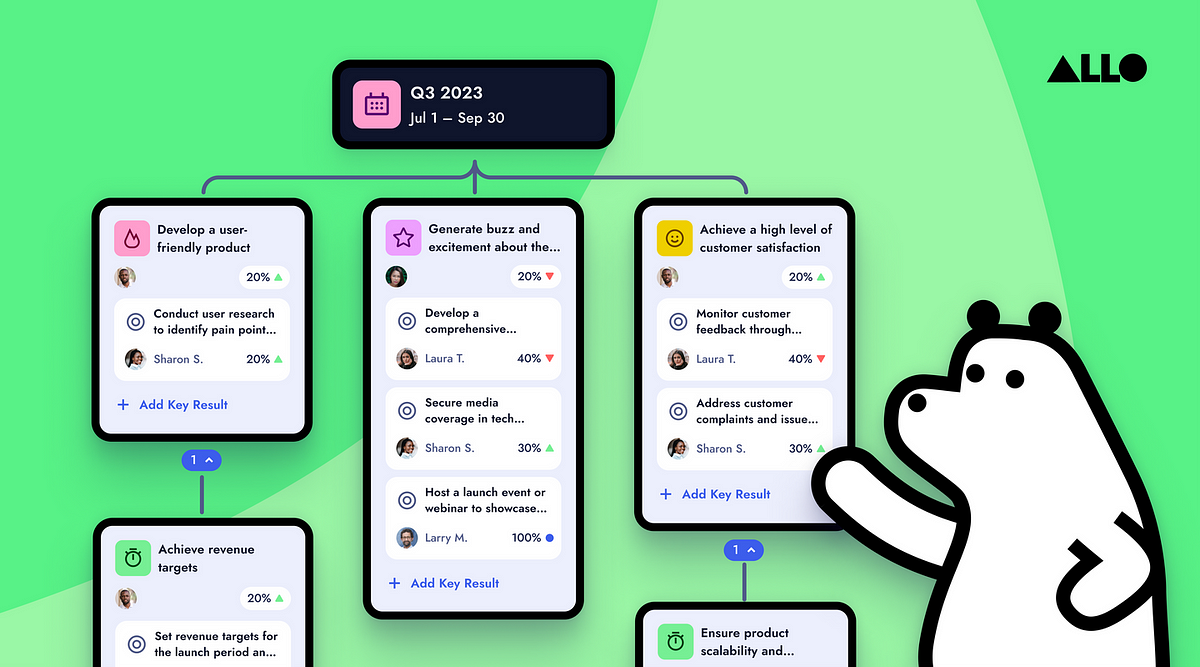Mastering OKRs in 2023: Answering the 9 Most Common FAQs and 11 Myths

Objectives and Key Results (OKRs) are a popular framework for goal setting and strategic alignment. But like any new methodology, OKRs come with their fair share of questions and misconceptions. In this article, we'll tackle the most frequently asked questions about OKRs and dispel some common myths.
FAQs About OKRs
Here are answers to some of the most common OKR questions:
1. What are the main benefits of OKRs?
The OKR framework offers many benefits, including increased focus, alignment, transparency, accountability, agility, and ambition. OKRs keep teams focused on the most important goals and provide a line of sight into how their work ladders up to company objectives.
2. How often should OKRs be set?
Most companies set OKRs on a quarterly cadence. Setting them more frequently can lead to a lack of focus, while less often can reduce accountability. Quarterly OKRs balance the ability to adapt with the need for consistency.
3. Should OKRs be tied to employee evaluations?
No, OKRs should not be directly tied to performance evaluations or compensation. While OKR performance can provide useful input for reviews, associating them too closely with evaluations often backfires. Employees tend to set easily achievable objectives and conservative key results to assure positive reviews and maximize incentives. This works against the ambitious stretch goals that OKRs are designed to encourage.
By separating OKRs from compensation and career outcomes, organizations create a safe space for bold thinking and taking reasoned risks. Failure to achieve audacious OKRs should be seen as a learning opportunity, not the basis for negative reviews or penalties. Reviews should focus more on the process - were intelligent risks taken, insights gathered, and adjustments made? This promotes the growth mindset needed for OKRs to drive innovation.
4. Can OKRs and KPIs be used together?
Yes, but KPIs require additional strategic context to become effective OKR key results. KPIs are ongoing metrics that track health and performance. But OKRs drive strategic change through initiatives tied to ambitious outcomes. While related, flipping a KPI into a key result alone is rarely enough. The OKR should explain how that metric connects to larger goals through planned actions. KPIs and OKRs work best together when this context is provided.

5. How are OKRs different from other goal frameworks?
OKRs focus on outcomes rather than outputs, encourage frequent reassessment, and promote stretch goals. Other frameworks like MBOS and KPIs focus more on cascaded targets, less frequent adjustment, and maintaining standards.
6. What percentage of completion indicates a "good" OKR?
Typically 60-70% completion of key results is considered good for an ambitious OKR. 100% completion may mean the goal wasn't stretchy enough. Less than 50% may indicate a problem with execution.
7. Should all OKRs be shared publicly?
Transparency is key to OKR success, but a small subset around sensitive topics like finances may be kept partially private if necessary while still sharing them with relevant internal stakeholders. However, the vast majority of OKRs should be open to encourage alignment and prevent silos. Even confidential OKRs gain from input by those executing them.
8. How many OKRs should a team or individual set?
The recommended limit is 3-5 objectives per quarterly time period. Much more than 5 objectives leads to scattered focus and diluted effort. However, fewer than 3 may constrain thinking. Each objective should also have between 3-5 key results that indicate success. Restricting both objectives and key results avoids the common pitfall of OKR overload.
9. Should individual OKRs cascade from team or company goals?
Individual OKRs are best set collaboratively, not just cascaded top-down from the team or company. While individuals should see how their goals ladder up to broader objectives, they should also be empowered to bring ideas and key results aligned to team and company OKRs. This promotes engagement and prevents cascades from limiting ambition and creativity.
Common Myths and Misconceptions About OKRs
Myth 1: OKRs are just a to-do list
Reality: OKRs focus on strategic outcomes, not tasks. They outline what success looks like, not how to get there. For example, an OKR to "Increase customer retention by 15%" defines the outcome, not specific tasks like "Email customers about new features."
Myth 2: OKRs cascade from the top-down
Reality: OKRs align vertically and horizontally. Teams create goals that ladder up to company objectives but also align with peer teams. For instance, the marketing team's OKR to "Launch 3 viral social campaigns" aligns to the company OKR to "Grow site traffic by 40%."
Myth 3: OKRs guarantee strategy execution
Reality: OKRs enable strategy execution through alignment and focus. But execution depends on great leadership, culture, and follow-through. Setting an OKR to "Release our new app in Europe" won't ensure success if the rollout plan has flaws.
Myth 4: OKRs are only for high-tech companies
Reality: Companies across industries from finance to government to retail use OKRs successfully. The framework is versatile. For example, a retailer's OKR to "Increase mobile purchases by 30%" applies the methodology beyond just tech.
Myth 5: OKRs require expensive software
Reality: OKRs thrive when software is intuitive and collaborative first, expensive and complex last. Costly HR platforms often isolate OKRs from most employees. Lightweight options that prioritize features like visuals, integration, and accessibility over analytics keep costs down while encouraging participation across the company. The goal should be engagement and transparency, not top-down reporting.

Myth 6: OKRs are just rebranded MBOS
Reality: While related, OKRs focus more on outcomes than duties, promote stretch goals, and encourage transparency. Unlike MBOS, an OKR to "Launch in 2 new cities" encourages big thinking rather than task management.
Myth 7: OKRs are a passing fad
Reality: OKRs have been used successfully for decades by industry leaders like Google, Amazon, and Intel. The framework has stood the test of time. For example, Intel pioneered OKRs in the 1970s and still uses them today.
Myth 8: OKRs only work for specific departments
Reality: OKRs can work across all teams and levels of an organization - from sales to engineering to marketing and more. For instance, companies like Adobe have adopted OKRs company-wide, finding success in departments ranging from finance to HR.
Myth 9: OKRs stifle creativity
Reality: Well-crafted OKRs provide a framework for ambition while giving teams flexibility to innovate on how they achieve goals. For example, an OKR to "increase app engagement" allows creative freedom to still try new features and concepts.
Myth 10: OKRs encourage risky short-term thinking
Reality: OKRs are structured into quarterly cycles specifically to discourage short-term priorities. They foster sustainable growth. For instance, stretching OKRs over longer timeframes prevents reactionary goal-setting and focuses on the horizon.
Myth 11: OKRs represent a complete strategy
Reality: OKRs are a tool for executing on strategy - but don't replace thorough strategic planning itself. For example, OKRs to enter a new market require backing business plans and research.
Conclusion
OKRs represent an exciting new approach to goal setting that is transforming organizations across industries. However, like any new methodology, misconceptions and myths exist that can derail successful OKR adoption. By understanding common FAQs and false narratives, organizations can thoughtfully implement OKRs while avoiding pitfalls.
The key is to recognize that OKRs are about strategic alignment and ambition, not cascaded task lists or guarantees. With the right mindset and culture, the OKR framework offers immense potential to unite teams, accelerate growth, and achieve the once impossible. Approached properly and tailored to your organization's needs, OKRs can take your company goals to the next level.
Learn more:







